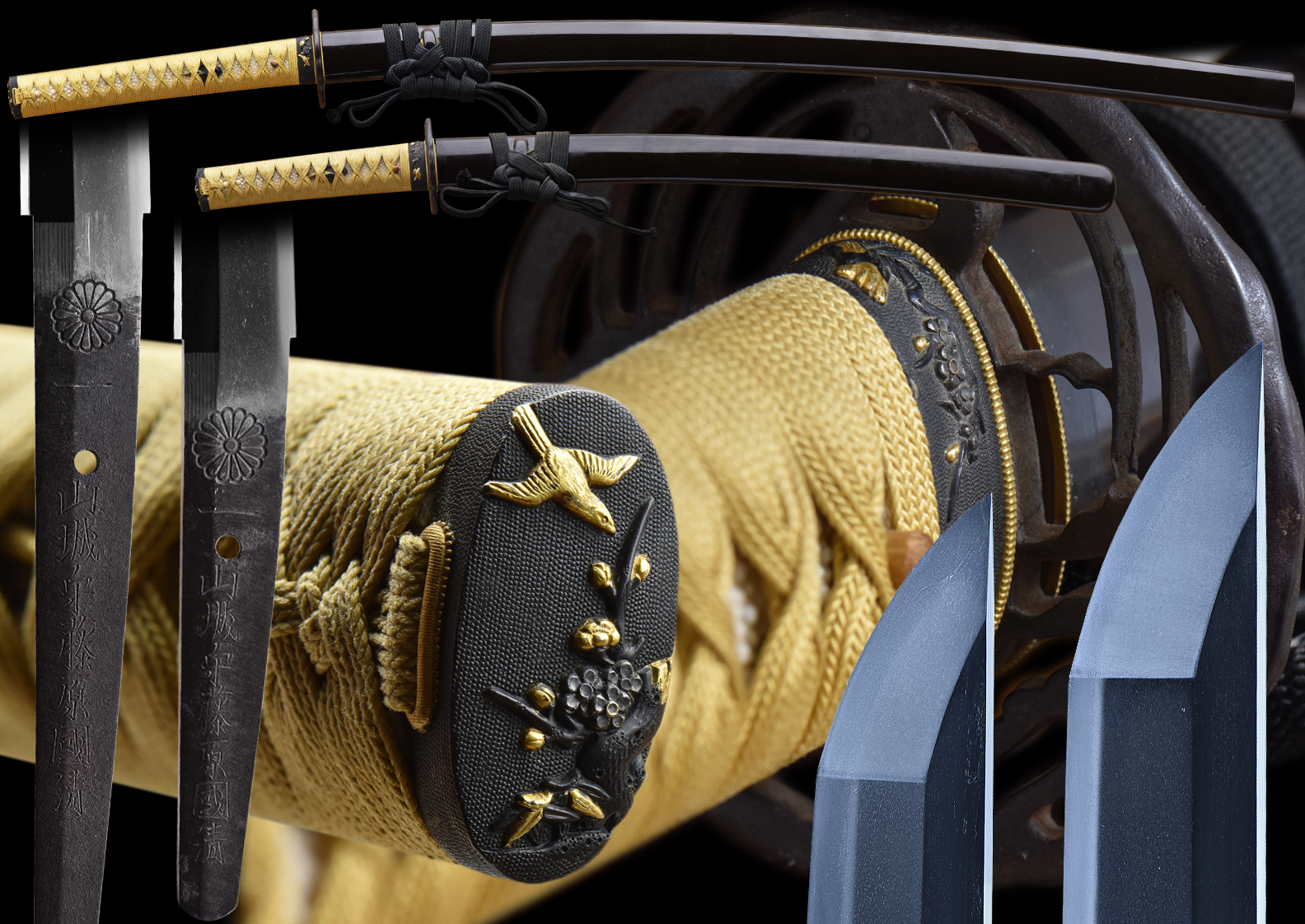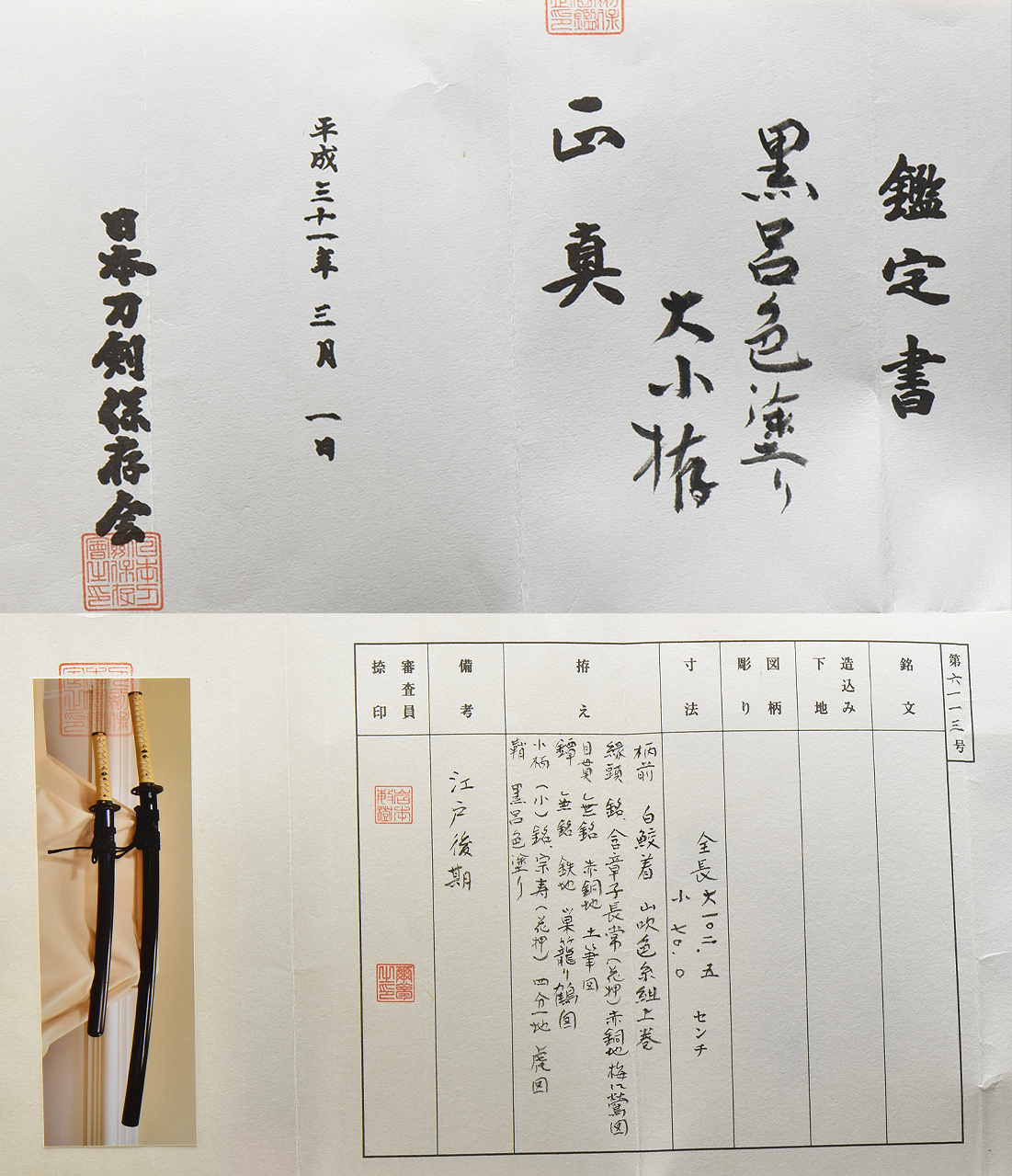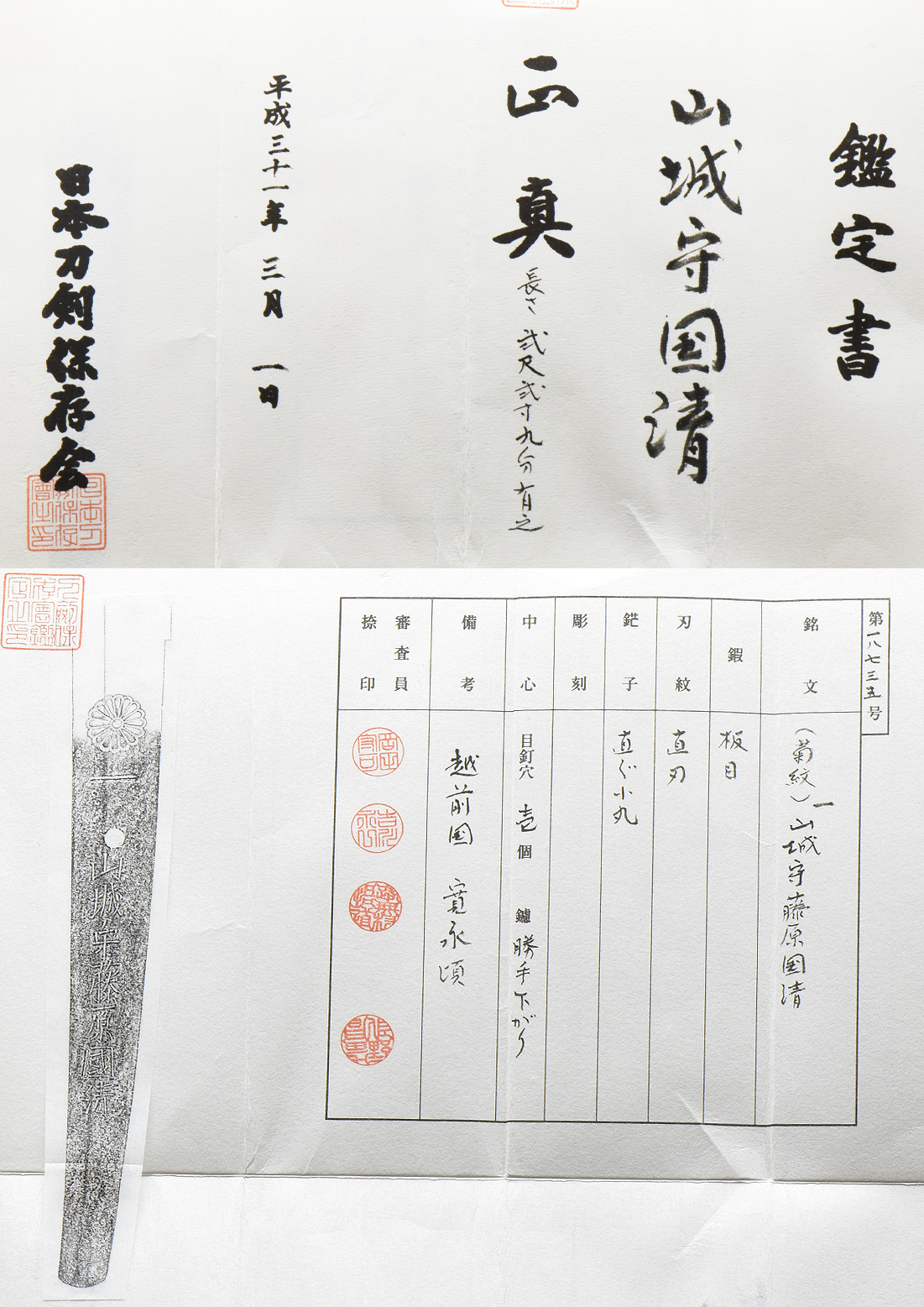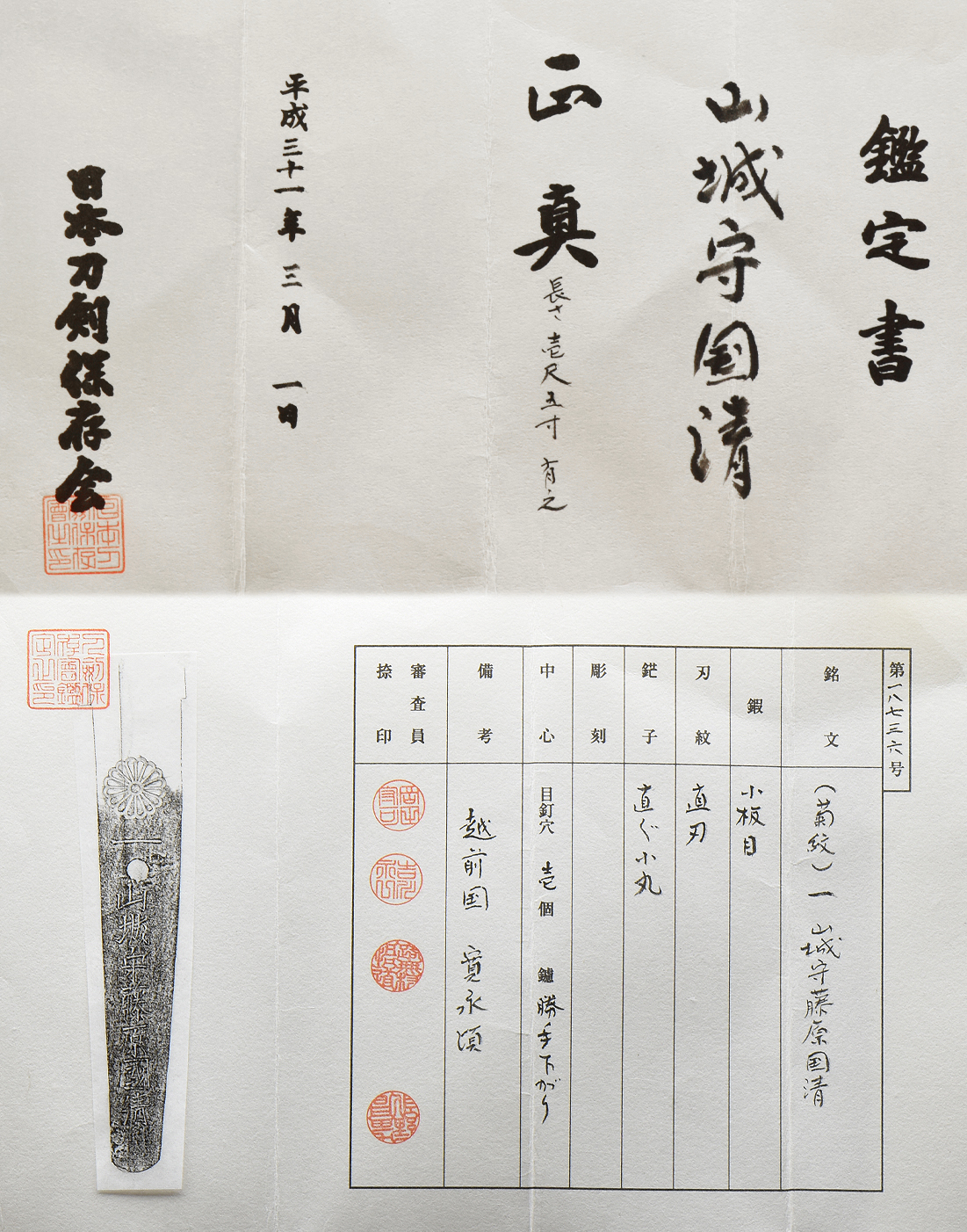Yamashiro kami Fujiwara Kunikiyo is a son of Shimada Sukemune.
born at Shinshu Matsumoto province.
After that he studied under Horikawa Kunihiro.
He changed his name to Kunikiyo and after Kanei 4th, he got the title of the Yamashiro Daijo.
and after that he changed it to Yamashiro no Kami.
After his great master Kunihiro passed away, he moved to Matsumoto Shinsyu province and from thereHe moved to Echizen province and followed Daimyo Matsudaira who was ordered to move Echizen
by Tokugawa Shogun. This era is his most skilled years.
He passed away Keian 2nd at 60 years of age..
Kunikiyo is famous for his style of sugu-ha and hada akin to Hizen Tadahiro and can be mistaken for the best of Hizen Tadahiro work. The hada can appear to be veryb similar to honoku hada made dfamous by the Hizen school but with a Horikawa Kunihiro flare. This is an exceptional Daisho that high end collectors look for and cherish when found.
Dr. Kanzan Sato, former director of the NBTHK (the sword museum of
Japan) writes in his book The Japanese Sword that Yamashiro no Kami Kunikiyo was the most famous swordsmith in the Shinto (Edo
period) that was granted permission to stamp the 16-petal kiku-mon imperial family chrysanthemum on the nakago of his swords. Kunikiyo first left his hometown of Suruga province to Kyoto and became a star student of grandmaster swordsmith Horikawa Kunihiro. He received the Horikawa kanji character for Kuni whereupon he became Kunikiyo. He left Kyoto in 1614 after his master’s death. Kunikiyo was retained by the powerful daimyo (lord) MatsudairaTadamasa and moved to Fukui to join him in 1624. Only the finest smiths could be retained by such royalty in Japan. In 1627 he received the honorary title Yamashiro no Daijo which is when he received permission to engrave the 16-petal kikumon. A year later, in 1628, Kunikiyo’s title became the more prestigious Yamashiro no Kami (Lord of Yamashiro [Kyoto] province). Kunikiyo is thought to have died in the second year of Keian (1649) at the age of 60. Several generations of Kunikiyo followed. Kunikiyo is renowned for producing a fine suguha (Straight) hamon. Rarely are we treated to such a wonderful Soshu creation with thick nioguchi in gunome midare and plenty of hataraki that we see in this katana. He would have learned these skills from his time under Kunihiro.
This blade comes mounted in the original Daisho Koshirae. Please note that the mounts where displayed for many years with one side out and the other to the sunlight. Therefore one side shows a little fading on both koshirai. This however does not detract from these amounts as they are completely original and of super quality. The wearing of daishō was limited to the samurai class, and became a symbol or badge of their rank. Daishō may have became popular around the end of the Muromachi period (1336 to 1573)as several early examples date from the late sixteenth century.An edict in 1629 defining the duties of a samurai required the wearing of a daishō when on official duty. During the Meiji period an edict was passed in 1871 abolishing the requirement of the wearing of daishō by samurai, and in 1876 the wearing of swords in public by most of Japan’s population was banned; this ended the use of the daishō as the symbol of the samurai, and the samurai class was abolished soon after the sword ban. This pair is elegantly lacquered in a gloss black/brown. The tsuba is of a matching iron sukashi crane design. The fuchi/kashira are of a lovely shakudo and gold signed with the artist’s kao. The menuki are of exceptional also. The motif is of a bird with a floral drop. The tsukamaki is original and in an elegant gold string wrap all original to the sword. The sageo’s antique and are black.
- KATANA
- Mei: Yamashiro no Kuni Kunikiyo and kiku-mon (mark of the chrysanthemum) Ichi
- Date: Edo (1600’s-1700’s)
- Nagasa: 27-1/4 inches
- Sori: 15.0 mm
- Width at the ha-machi: 32.2 mm
- Width at the yokote: 21.7 mm
- Thickness at the mune-machi: 6.7 mm
- Construction: Shinogi zukuri
- Mune: Iori
- Nakago: Ubu
- Kitae: Itame
- Hamon: Suguba
- Boshi: Maru
- Condition: Good polish
- WAKAZASHI
- Mei:
- Yamashiro no Kuni Kunikiyo and kiku-mon (mark of the chrysanthemum) Ichi
- Date: Edo (1600’s-1700’s)
- Nagasa: 17-7/8 inches
- Sori: 13.8 mm
- Width at the ha-machi: 29.5 mm
- Width at the yokote: 22.6 mm
- Thickness at the mune-machi: 7.4 mm
- Construction: Shinogi zukuri
- Mune: Iori
- Nakago: Ubu
- Kitae: Itame
- Hamon: Suguba
- Boshi: Maru
- Condition: Good polish
Click to Enlarge Image
Click to Enlarge Image
Swords come mounted in these shirasaya and the mounts have tsunagi to display them properly.
山城守藤原國清
刃長二尺二寸八分
一九八◯年為ロバートAコールマン氏
薫山誌「花押」
Yamashiro no Kami Fujiwara Kunikiyo
Hachō 2 shaku 2 sun 8 bu
1980-nen
Kunzan shirusu + kaō
Yamashiro no Kami Fujiwara Kunikiyo
Blade length ~ 69.1 cm
Written by Kunzan [Honma Junji] in 1980+ monogram
Click to Enlarge Image
Click to Enlarge Image
Fuchigashira, signed: Ganshōshi Nagatsune + kaō(含章子長常「花押」), shakudō, motif of bush warbler in plum tree
Click to Enlarge Image
Kantei-sho (鑑定書) – Appraisal
Kuro roiro-nuri daishō-koshirae (黒呂色塗り大小拵) – Daishō-koshirae featuring glossy black-lacquer scabbards
shōshin (正真) – Authentic
Heisei 31 nen 3 gatsu 1 nichi (平成三十一年三月一日) – March 1, 2019
Nihon Tōken Hozon Kai (日本刀剣保存会) – NTHK
No 6113
meibun (銘文) – Signature:
tsukurikomi (造り込み) – Shape:
shitaji (下地) – Foundation:
zugara (図柄) – Motif:
hori (彫り) – Carvings:
sunpō (寸法) – Measurements: overall length dai 102.5 cm, shō 70.0 cm
koshirae (拵え) – Mounting: Hilt: covered with white same and wrapped kumiage style with golden yellow braid.
Fuchigashira, signed: Ganshōshi Nagatsune + kaō (含章子長常「花押」), shakudō, motif of bush warbler in plum tree
Tsuba : unsigned, shakudō, horsetail motif
Kozuka (on shō ), signed: Sōju + kaō (宗寿「花押」), shibuichi, tiger motif
Saya : glossy black-lacquer
bikō (備考) – Remarks: late Edo period
shinsa’in natsu’in (審査員捺印) – Seals of Judges: 2 seals
This NBTHK paper was one of the original papers that came with the swords. The wakazashi papers were misplaced. The swords were newly papered this last year. New owner will receive four papers in total. One NBTHK paper and three NTHK papers. The mounts are also papered.
Nintei-Sho (認定書) – Appraisal
No 19509
Katana, signed: Kiku’mon Ichi Yamashiro no Kami Fujiwara Kunikiyo
(菊紋一山城守藤原国清) – “(Chrysanthemum crest)
Ichi, Yamashiro no Kami Fujiwara Kunikiyo”
nagasa ~ 69.3 cm
According to the result of the shinsa committee of our society, we judge this work as authentic and rank it as Kōshu-Tokubetsu-Kichō Tōken.
February 27, 1980
[Foundation] Nihon Bijutsu Tōken Hozon Kyōkai, NBTHK (日本美術刀劍保存協會)
[President] Honma Junji (本間順治)
(shipping and insurance included)
Email us if your interested in this item and remember to include the order number for this item: fss-849.
(KATANA DETAILS)
Click to Enlarge Image
(WAKAZASHI DETAILS)
Click to Enlarge Image
Click to Enlarge Image
Kantei-sho (鑑定書) – Appraisal
Yamashiro no Kami Kunikiyo (山城守国清)
shōshin (正真) – Authentic
nagasa 2 shaku 2 sun 9 bu kore ari (長さ弐尺弐寸九分有之) – Blade length ~ 69.4 cm
Heisei 31 nen 3 gatsu 1 nichi (平成三十一年三月一日) – March 1, 2019
Nihon Tōken Hozon Kai (日本刀剣保存会) – NTHK
No 18735
meibun (銘文) – Signature: (Kiku-mon) Ichi Yamashiro no Kami Fujiwara Kunikiyo
(「菊紋」一 山城守藤原国清) – “(Chrysanthemum crest)
Ichi, Yamashiro no Kami Fujiwara Kunikiyo”
kitae (鍛) – Forging: itame
hamon (刃紋) – Hardening: suguha
bōshi (鋩子) – Hardening in tip: sugu with a ko-maru-kaeri
chōkoku (彫刻) – Engravings:
nakago (中心) – Tang: mekugi-ana (目釘穴) 1, yasurime (鑢): katte-sagari
bikō (備考) – Remarks: Echizen province, around Kan’ei (寛永, 1624-1644)
shinsa’in natsu’in (審査員捺印) – Seals of Judges: 4 seals
Click to Enlarge Image
Kantei-sho (鑑定書) – Appraisal
Yamashiro no Kami Kunikiyo (山城守国清)
shōshin (正真) – Authentic
nagasa 1 shaku 5 sun kore ari (長さ壱尺五寸有之) – Blade length ~ 45.4 cm
Heisei 31 nen 3 gatsu 1 nichi (平成三十一年三月一日) – March 1, 2019
Nihon Tōken Hozon Kai (日本刀剣保存会) – NTHK
No 18735
meibun (銘文) – Signature: (Kiku-mon) Ichi Yamashiro no Kami Fujiwara Kunikiyo
(「菊紋」一 山城守藤原国清) – “(Chrysanthemum crest)
Ichi, Yamashiro no Kami Fujiwara Kunikiyo”
kitae (鍛) – Forging: itame
hamon (刃紋) – Hardening: suguha
bōshi (鋩子) – Hardening in tip: sugu with a ko-maru-kaeri
chōkoku (彫刻) – Engravings:
nakago (中心) – Tang: mekugi-ana (目釘穴) 1, yasurime (鑢): katte-sagari
bikō (備考) – Remarks: Echizen province, around Kan’ei (寛永, 1624-1644)
shinsa’in natsu’in (審査員捺印) – Seals of Judges: 4 seals
For Sale
































